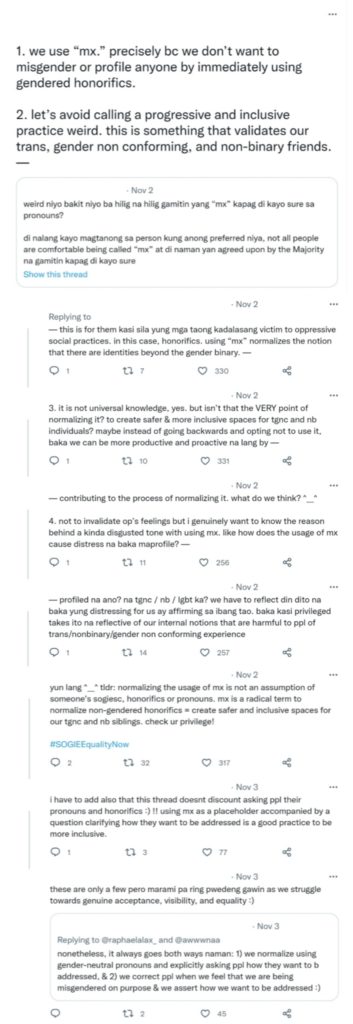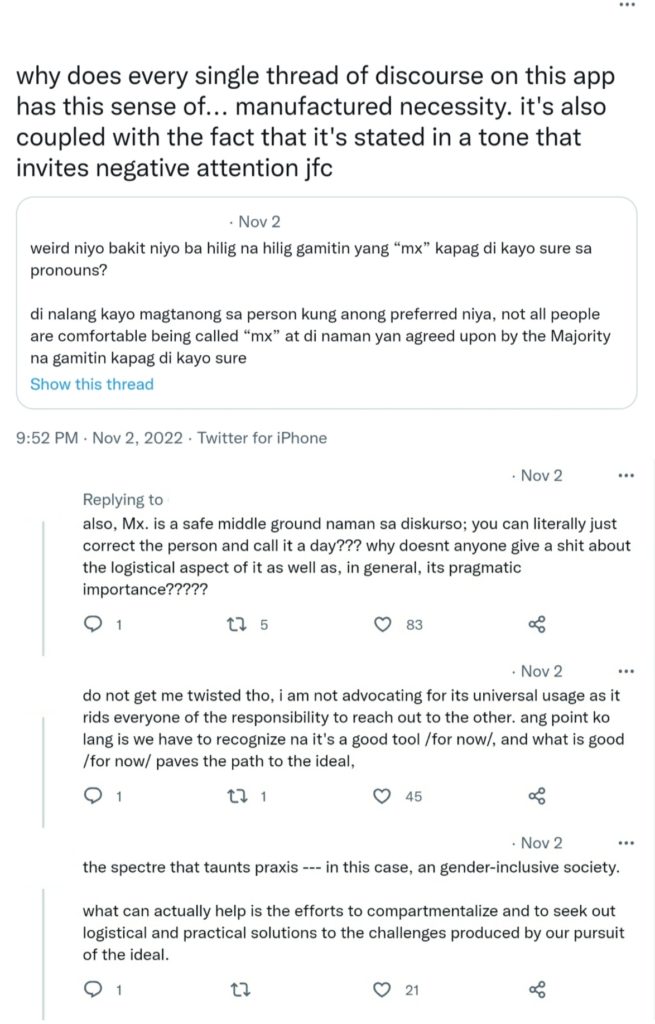Picture this: you want to be polite when addressing a stranger, but you’re afraid you might misgender them by using Mr., Ms., Mrs., or whatever gendered honorifics out there. You couldn’t call them by their name alone because you don’t feel that’s respectful enough, or simply because you really don’t know this person.
So, what can you do to avoid misgendering from happening? You can use a gender-neutral option: “Mx.”
Much like Mr., Ms., and Mrs., Mx. (pronounced mix) is a gender-neutral alternative to the gendered honorifics we’ve long been accustomed to using. This courtesy title is predominantly used among the LGBTQIA+ community, particularly many transgender, gender non-conforming, and nonbinary individuals, because Mx. provides them an “alternative to being identified by their gender,” preventing them to feel alienated.

While the use of Mx. actually goes way back to the 1970s, it was only recently that the title gained traction and included in both Oxford English Dictionary and Merriam-Webster Dictionary. Many people have already been practicing the use of it in different settings—be it in a casual conversation or a workplace.
Despite its recognition, the usage of Mx. still sparks controversy from time to time, to date. Recently on Twitter, the discourse on whether to use Mx., instead of asking, to address someone has been brought to light.
In a thread, one user wrote: “[W]eird niyo, bakit ba hilig niyo gamitin ‘yang ‘Mx.’ kapag di kayo sure sa pronouns? (You’re all weird. Why do you keep using ‘Mx.’ when you’re not sure of someone’s pronouns?)”
She continued: “Di na lang kayo magtanong kung anong prefer niya. Not all people are comfortable being called ‘Mx.’ at ‘di naman yan agreed upon by the majority na gamitin kapag di kayo sure. (Why don’t you ask about their preferred titles? Not all people are comfortable with being called ‘Mx.’ and the use of ‘Mx.’ isn’t even agreed by the majority when you’re not sure of someone’s title.)”

She also added that while Mx. has its advantages, its usage may leave a wrong impression on some people since Mx. isn’t “a universal knowledge” and isn’t “widely used.”
She then ended her thread by saying: “Nothing against Mx. mismo, like wala ako[ng] issue sa mga gusto ng Mx. na honorific or whatever, pero kung ‘di naman ‘yun ang preferred at all tas ‘yun pa [rin] ang ginagamit, kakaadwa talaga. (I have nothing against Mx. and those who use it as an honorific or whatever, but if that isn’t the person’s preferred title yet you still use it, it’s revolting.)”
The tweet has since blown up and many users also shared their sentiments on OP’s take. Some explained the relevance of Mx., saying that the reason behind this practice is to avoid misgendering.








Others also stated that there are people who aren’t comfortable being asked about their preferred titles; thus, they resort to using Mx.



On the other hand, some users have also called out OP for describing the usage of Mx. as “weird.”




Now let’s get some things straight. TBH, I do get where OP is coming from. I mean, we can always ask the other person for their preferred title because in that way, we can address them based on their affirmed gender.
But then again, as everyone has pointed out, not all the time, you’ll be given the chance to ask, especially if it’s only the first time you’re communicating with the person you’re about to address.
We also have to take note that not everyone is also comfortable with being asked. There’s a possibility that the person we would be asking may be experiencing gender dysphoria and is still struggling to find what honorifics work best for them.
Of course, I’m not discounting our social responsibility to ask, but we have to understand that this is just one of the reasons why there are people who are uncomfortable with being asked for their preferred titles (as well as their pronouns).
“But you can always call them by their name.” Yes, you can always do that. However, for some people, they may feel that they’re not respectful or polite enough when they just call someone by their given or preferred name, especially if they’re addressing their boss, supervisor, or someone they think is superior.
Not to mention, referring to someone with their first name and without honorifics can be odd for some cultures, particularly Asian cultures (but let’s save that story for another day).
Another thing that I find perplexing in OP’s take is describing the usage of Mx. as “weird.”
As I’ve mentioned in the earlier part of this article, and as many have pointed out, we use Mx. to avoid misgendering someone.
Mr., Ms., and Mrs. are all gendered terms. Meaning to say, they denote that gender is only binary. Using gendered titles to refer to individuals who are gender nonconforming, nonbinary, and transgender can negatively impact their self-confidence and mental health. Not only that but it also reinforces heteronormative practices.
Using gender-neutral language won’t harm anyone, and if a person stated their preferred title, we would address them based on their preference. We wouldn’t misgender someone on purpose. And if, for instance, we have misgendered anyone, we would acknowledge our mistakes, correct them, and continue to be mindful.
“But Mx. isn’t a universal knowledge and widely used, and this might confuse them.” Sure, not everyone is aware of what Mx. is, but isn’t that the reason why we’re using it? To raise awareness and educate the public about it?
By practicing its usage, we’re introducing to them the gender-neutral alternatives to the terms we’ve been accustomed to using. We’re also teaching them the importance of normalizing gender-neutral language and how it can help achieve the equality we’re fighting for.
In a country, like the Philippines, which has yet to achieve gender equality—let alone accept the LGBTQIA+ community, using gender-neutral language is a small step we can take to create an inclusive environment for everyone. While doing this may not lead to a sudden change, it can help challenge harmful norms.
After all, language is a powerful tool, and we can harness its power and use it to advance social progress.
Other POP! stories you might like:
Commentary: Is P35,000 still a livable wage in the Philippines?
Commentary: What is war good for? Meme content, apparently
Are we just so used to dark humor or have we become so desensitized.



